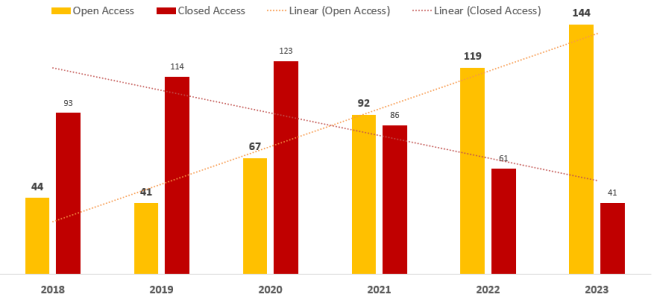78% of the journal articles published by our researchers in 2023 were open-access, compared to 66% in 2022, 52% in 2021, and 35% in 2020. This progress is driven by our Read and Publish agreements with major publishers, the OA mandates of many funders, and the conviction of most researchers that open-access publishing is good for them. But is this “gold route” sustainable in the long term?
A good harvest
Read & publish agreements cover article processing charges in hybrid (partly open) and sometimes Gold (fully open) journals. In 2023, the Geneva Graduate Institute had such agreements with 7 publishers: Cambridge University Press, Elsevier, Oxford University Press, Sage, Springer, Taylor & Francis and Wiley. The annual quota for Taylor & Francis was higher than in previous years, and was reached only a few days before Christmas (versus early July in 2021 and October 20th in 2022). All the conditions were therefore in place for a high number of OA publications under these agreements.
Our professors, researchers, PhD and even some Master’s students have benefited with a total of 66 articles covered. For the publication of 36 more articles, they benefited as co-authors from the Read & Publish agreements signed by other universities the corresponding author belonged to. Similarly, our agreements also indirectly benefit co-author researchers from other universities.
Hopes not fulfilled
The vast majority of these articles were published in so-called “hybrid journals”, i.e. journals that are essentially subscription journals, but offer researchers the option of publishing their articles open-access. This requires them to benefit from R&P agreements or find funding to pay the (inflated) publication fees. Most funders and many librarians dislike hybrid journals, which they see as just another way for publishers to make more profit, and which perpetuate an inequality between researchers based solely on funding.
The original objective was for the agreements to be “transformative”, eventually turning these journals to a full gold model, but these hopes are not materialising even in mostly OA titles, their publishers maintaining a subscription model. One of the main reasons why these hopes have not been fulfilled is that R&P agreements have remained a Western European model, which has not really been successful elsewhere. North America prefers traditional Gold OA, while Eastern Europe and Latin America favour Diamond (free for readers and authors alike). Researchers based in the Global South, often with limited funding options, try to find a way to publish anyway.
Another reason for disappointment is cost. It was hoped that R&P agreements would make it possible to limit the rise in costs caused by the “serials crisis”, the steady increase in subscription prices over the recent decades causing financial sustainability to be an issue. This is not the case: prices are still rising, and negotiations with publishers are tough: Swiss libraries have not been able to reach an agreement with Elsevier for 2024 so far, and are de facto in a no-deal situation with this giant publisher. R&P agreements are therefore a precarious solution, and no-deal situations with other publishers are likely to recur in the coming years.
Diamond is the new Gold
Funders and European universities are therefore beginning to look towards Latin America, which has been following its diamond route for several decades. Diamond journals are journals with no subscription or publication fees, usually funded by universities, libraries, learned societies, research funders, and sometimes by bits and bobs. Could diamond journals be the future of academic publishing?
In 2023, 16 articles authored by Graduate Institute researchers were published in diamond journals, some of which are based in Latin America. The Graduate Institute has its own diamond journal, International Development Policy. But in Western Europe, these journals remain a fragile niche sector. There are therefore many initiatives and projects to strengthen diamond journals in Switzerland and Europe, such as Diamas. And diamond OA has become a sexy topic at librarians’ meetings.
Of course, it is doubtful whether these efforts will be sufficient to build an alternative to profit-driven academic publishing. Especially if the “publish or perish” culture, with its many perverse incentives, persists, and if the way researchers are evaluated does not change.
To learn more about open access, check Catherine’s guide on the subject.
